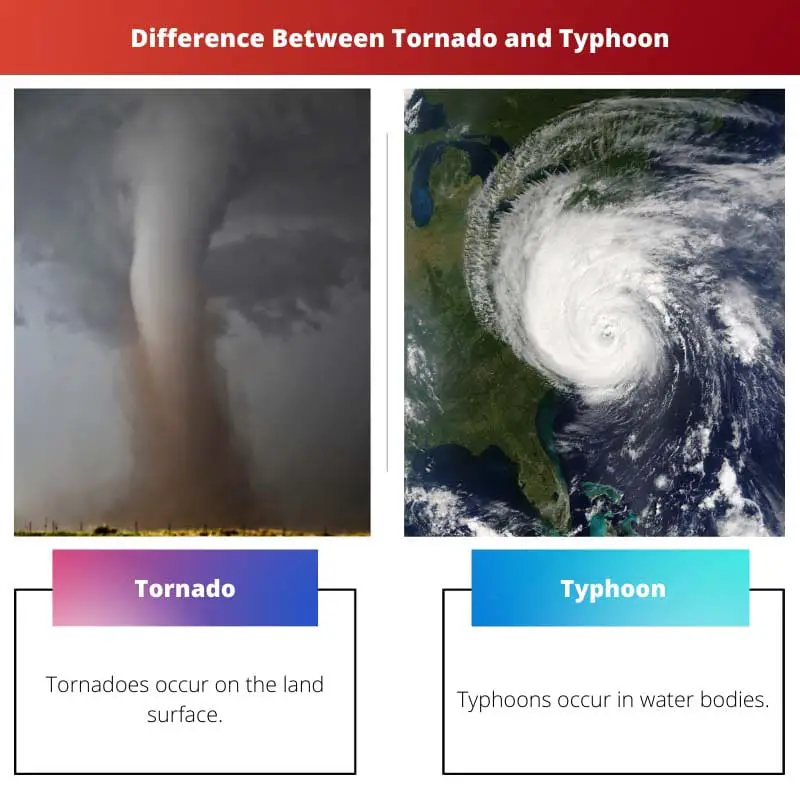On Earth, various weather phenomena occur, like cyclones, hurricanes, storms etc. Typhoons and Tornados are part of the weather phenomena.
Key Takeaways
- Tornadoes are a type of severe weather that occurs over land, while typhoons are a type of severe weather that occurs over the ocean.
- Tornadoes are formed by rotating columns of air that extend from the base of a thunderstorm to the ground, while typhoons are formed by rotating tropical storms over warm ocean waters.
- Tornadoes are more common in the United States and other parts of the world with a temperate climate, while typhoons are more common in the western Pacific Ocean.
Tornado vs Typhoon
Tornadoes occur on the ground and are 50 to 100 feet long. There are 3 types of tornadoes: Multiple Vortexes, landspouts, and Waterspouts. While typhoons develop over water bodies and are up to hundreds of miles. According to a scale of 1 to 5, typhoons are classified according to their wind speed.

A tornado forms violently when air spins violently and has contact between the land surface and cumulonimbus clouds. Commonly it is referred to by the name twister or whirlwind.
Typhoons are the more severe form of cyclones and occur in the northwest Pacific ocean in countries like China, Japan, Taiwan, and the Philippines. It appears in every part of the world but is referred to by different names.
Comparison Table
| Parameter of Comparison | Tornado | Typhoon |
|---|---|---|
| Formation | Tornadoes occur on the land surface. | Typhoons occur in water bodies. |
| Category | Tornadoes can be classified into Multiple Vortex, Landspout, and Waterspout. | Typhoons are categorised based on their windspeed on the level of 1 to 5. |
| Size | Tornadoes can be 50 to 100 feet long. | Typhoons can be up to hundreds of miles. |
| Season | It occurs during the Spring and Summer seasons. | It occurs during mid-summer to early rainfall. |
| Area | Tornadoes are most common in North American and European countries. | Typhoons are most common in the North-west Pacific Ocean. |
What is Tornado?
A tornado is a form of a storm that occurs in hot and humid areas during the time of Spring and Summer seasons in the northern hemisphere. There should be a combination of both hot and cold air to form tornadoes.
Tornadoes form rotating and spinning columns with the help of powerful winds. Vortex can be both horizontal and vertical.
Tornadoes also occur on the water but cannot be considered tornadoes. It occurs in tropical countries closer to the equator or at low latitudes.

What is Typhoon?
A typhoon is a tropical cyclone developing in the North-West Pacific Region. It is said to be the most active region on earth where typhoons are likely to appear.
There is no fixed season when typhoons will occur. But the strongest and most destructive typhoons occur between June and November.
Typhoons range up to hundreds of miles wide and can have a wind speed of 157 miles per hour. The weakest typhoons are categorised into level 1, having a wind speed of 74 miles per hour.

Main Differences Between Tornado and Typhoon
- Tornadoes occur on land and water but cannot be said to be tornadoes. Typhoons only occur in water bodies.
- Tornadoes can be classified into Multiple Vortex, Landspout and Waterspout. Typhoons are categorised based on their windspeed from 1 to 5 ranging from 70 miles to 160 miles per hour.
- Tornadoes can be 50 to 100 feet long. Typhoons can be hundreds of miles and 155-170 feet deep.
- A tornado occurs during the Spring and Summer seasons. Typhoon occurs during mid-summer to early rainfall but can occur at any time of the year.
- Tornadoes are most common in North American and European countries. Typhoons are most common in the North-west Pacific Ocean.





